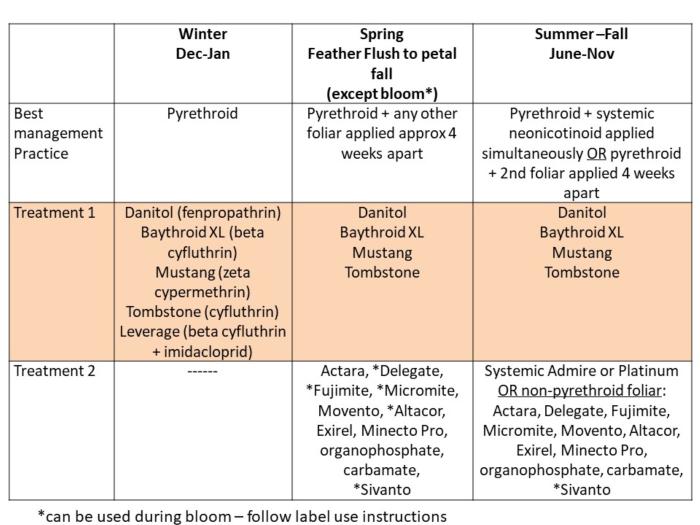Eradication strategy
Treatment Approach
Principles for treating commercial citrus orchards following the first appearance of ACP or where aggressive action is being taken in HLB quarantine areas:
- Apply two ACP effective insecticides with different modes of action as soon as possible after detection of ACP, with at least one from the broad spectrum group. The best treatment combination is a foliar pyrethroid (Baythroid, Danitol, Tombstone, or Mustang) plus a systemic neonicotinoid (Admire Pro or generic imidacloprid, Platinum). Apply the foliar first for rapid knockdown and the systemic close to the same time since it takes time for uptake into the tree. Use a systemic only if it will be effective; proper irrigation, soil type, and appropriate timing (June-October).
- If a systemic neonicotinoid cannot be used, then apply two foliar applications approximately 1 month apart (within a life cycle of the insect). Use a pyrethroid or Actara first, followed by any ACP effective insecticide shown in the table with a different mode of action. If weather or other conditions delay applications, treat as soon as possible.
- Treat the find site and neighboring orchards at as close to the same time as possible, preferably within 2 weeks of each other to achieve the ‘area treatment effect’. All blocks that intersect an 800 m radius should be treated in their entirety. Blocks that are outside the 800 meters and are in the direction of prevailing winds should also be considered for treatment.
Seasonal Aspects of the Program
Psyllids may be discovered in a new region at any time of year, yet insecticides may or may not be effective when the psyllid arrives. Below is a table suggesting treatment strategies taking into consideration the seasons. Always be aware of REI, PHI, MRLs and maximum uses per season, which can influence the usefulness of some insecticides.
Winter: In the winter, the psyllid population consists primarily of adults, temperatures are cold and so some insecticides don’t work, and it is difficult to treat multiple times. Therefore, the recommendation in winter is to apply a pyrethroid.
Spring: The first insecticide should be a pyrethroid to get maximum kill of the psyllid, and the second insecticide can be a softer insecticide. However, if the ACP detection situation arises during bloom, treatment choices need to be adjusted to avoid hazards to pollinators.
Summer-fall: In summer and early fall, uptake of neonicotinoids is good and so these should be combined with the pyrethroid. The systemic will extend the length of control and improve control of nymphs.

